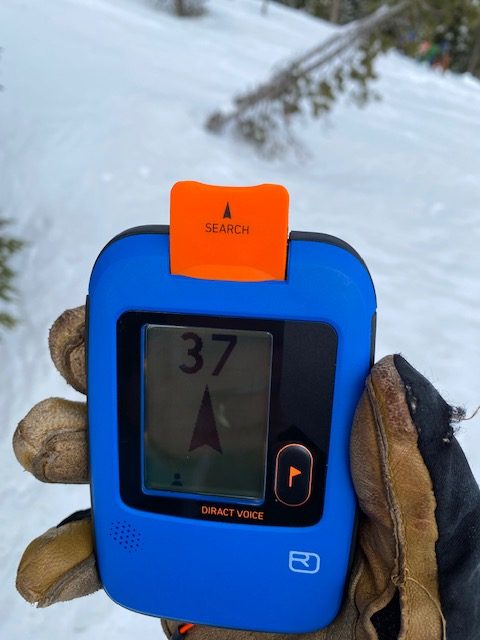
The Ortovox Diract Voice adds “integrated voice commands” to assist with searches.
By Kevin Grove
Risk, flow, and bliss: Something I have thought a great deal about over the years and continue to ponder and have lengthy discussions with friends and colleagues. Why do we do the things we do, and why do we put ourselves out there in dangerous mountain environments with numerous hazards? Grant Statham sums this up nicely in his TEDx talk about risk being the probability, or chance, of loss or gain.
Now that I have two daughters, the risk-reward balance resonates more. I have purposefully and mindfully increased my margins and decreased my own personal risk tolerance. My goals and priorities have shifted from multiple peak traverses, big ski lines, and riskier exploits to my new number one goal of coming home.
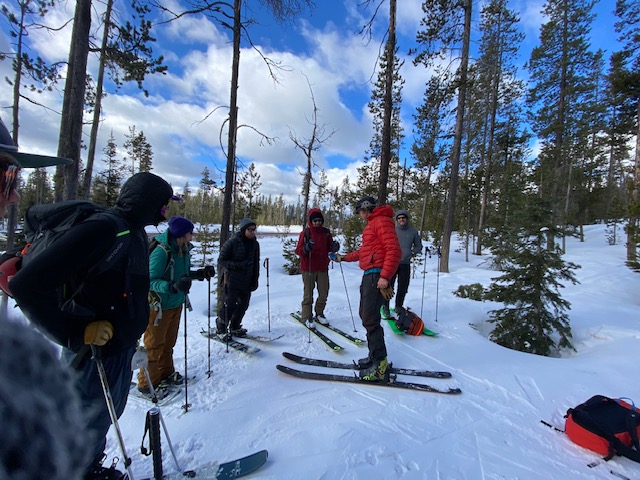
Kevin Grove teaching an avalanche recreational level 1 course outside Bend, Oregon— here he is conducting a group check with the Diract Voice.
When taking avalanche classes, buying rescue equipment, and practicing with that equipment, do any of us really think we will ever need to use it? I can tell you from personal experience that we are all human. We all make mistakes, and we are operating in a wicked environment with limited to no feedback until a mistake is made: which may be too late to learn a valuable lesson. In January 2010, I made a mistake and skied a slope on the shoulder of Middle Sister. I was luckily able to ski and claw my way off the slab and didn’t need to be rescued with a beacon, but after reflecting on this and other mistakes, I read avalanche accident reports with much more empathy and thoughts of ‘oh ya, that totally could have been me,’ instead of the classic, ‘how could they have been so stupid?” Research also points to older, possibly more experienced, backcountry users being in a higher risk category for fatal avalanche accidents than the youngest in the community. Something to ponder as I enter my fourth decade of mountain adventure.
Back to decreasing risk. What if we did all the right things: including taking an avalanche education course, reading the avalanche bulletin, having a conversation with our partners before going out about the current hazards, paying attention, and having solid situational awareness? It’s possible we still end up with a buried partner and need to use rescue gear. Do we have all the right equipment? Beacon- check. Probe – check. Shovel – check. Airbag – not yet. But, I need to consider this, as it significantly reduces our vulnerability if caught in an avalanche.
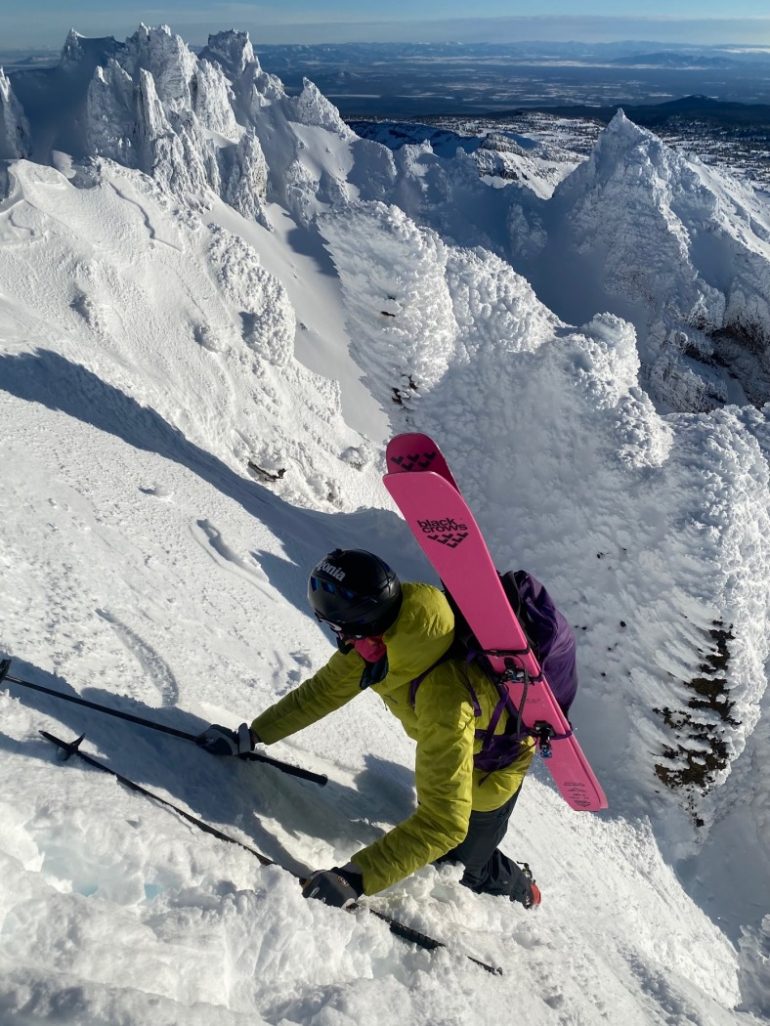
Risk, flow, and bliss: Why do we do the things we do, and why do we put ourselves out there in dangerous mountain environments with numerous hazards? Grant Statham sums this up nicely in his TEDx talk about risk being the probability, or chance, of loss or gain. Photo: Kevin Grove.
Rule number one is not getting caught in an avalanche in the first place— so many things go into this. Personally, I’m learning more about decision-making and human factor psychology.
Rule number two: if you fail at rule number one, you need to be fast and lucky. About 25% of all avalanche fatalities occur from trauma, and no amount of beacon speed or practice will increase these odds. Most of the other 75% die of asphyxiation. The longer you are buried, the more likely you will die. Shoveling takes a significant amount of time, so the beacon search needs to be fast. Speed is of the essence.
(Exponential decay graphs of avalanche asphyxiation deaths show about 92% of those buried survive if uncovered within 15 minutes. The survivability rate drops off quickly to 37% for those buried 35 minutes or longer. These are remarkable statistics and should encourage us all to practice more.)
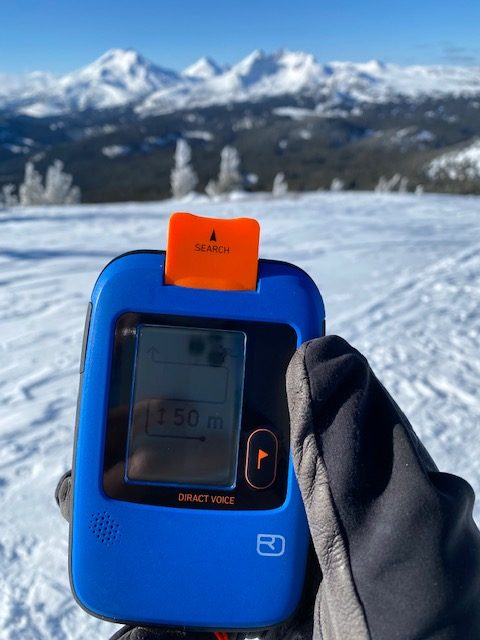
Beginning the course search with the Diract Voice. The flipped up orange tab indicates the beacon is set to “search”.
My mystery novel is finally getting to the meat of the story, the avalanche rescue beacon. This winter, I tested the Ortovox Diract Voice while teaching three avalanche recreational level 1 courses. The Diract Voice is the world’s first beacon to integrate voice commands to aid navigation. I have also been comparing the beacon and doing a head-to-head analysis with my current go-to, a Pieps Pro BT. This chart summarizes my findings of the head-to-head comparison as I talk through the features of the Diract Voice that I found appealing.
Flip Mechanism: The flip mechanism or toggle switch to move from off to send to search is straightforward to use, especially with gloved hands. It is fast, sleek, and efficient, moving from send to search. Auditory voice commands will let you know if you have not completed this switch and end up somewhere in between. I like the toggle switch on the Ortovox beacon slightly more than on the Pieps, so one check in that column.
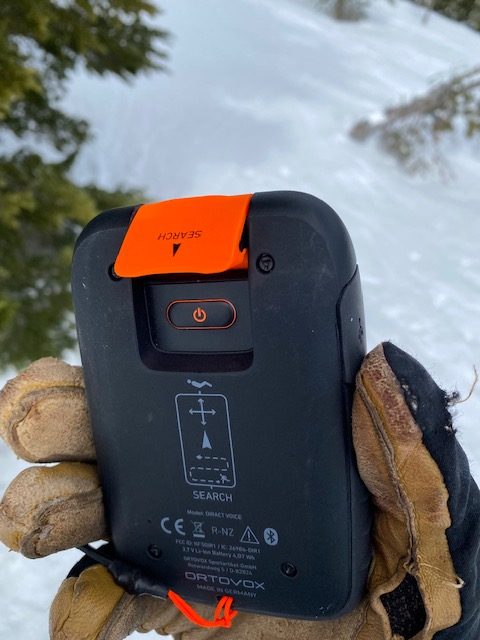
The on/off button is tucked under the orange tab, and is covered when in “send” mode. To prevent accidental shut down, the beacon prompts the user to press the FLAG button to confirm shut down.
Group Check: The Diract Voice group check function is obvious, intuitive, and works well. When the beacon is powered up, a group check option comes up on the screen, prompting the user to hit the flag button to initiate a group search. The group check feature on the Pieps beacon is not obvious or intuitive, and I have had to resort to looking at the manual (go figure) and still not figuring it out. I did figure it out a couple of months ago after web searching, but I tried to use it again last week and couldn’t recall or figure it out. Can someone please help me out here, so I don’t waste any more time on this one!
Ergonomics: The Ortovox beacon is sleek, svelt, and very well designed in the ergonomic category. The beacon fits well in my front pant pocket (my preferred technique) and has a functional harness if you prefer that carrying method. I also like some subtle features, including smooth corners and a long enough leash that actually functions in a search. Is it just me, or were beacon leashes incredibly small for many years? I always had to modify previous beacons to have a functioning leash system in search mode. It is interesting how little things can make a huge difference in performance. The Pieps beacon has many outstanding characteristics as well, but I gave a slight nod to the Ortovox here.
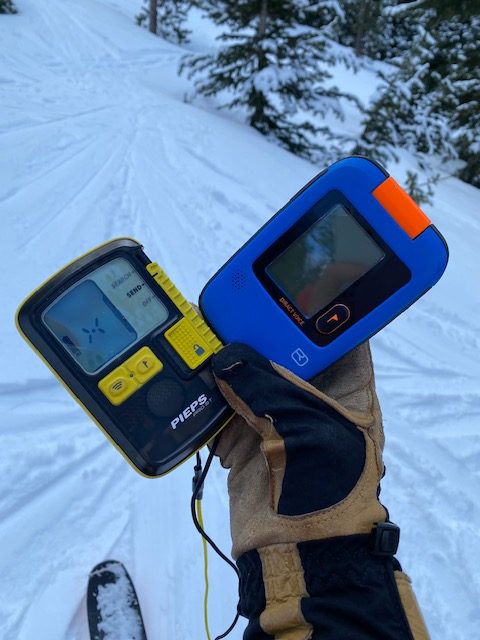
A side by side view of the Pieps Pro BT beacon and the Ortovox Diracty Voice.
Range: This is a big one for me. The Pieps won out in this category in all tests I performed and with significant margins. My Pieps consistently picked up a signal 10-15 meters before the Ortovox beacon when searching for buried beacons. The Pieps picked up signals around 50 meters while the Ortovox was more in the 35-40 meter range. This is significant. The increased range reduced my search times, which relates back to the exponential curve showing that every second counts.
Searching Features: The main feature setting the Diract Voice apart, and opening up a new category in beacon technology are its voice commands. Things like ‘run in 50m strip searches and look out,’ when first initiating a search, ‘drop to the snow surface,’ when getting within 2-3 meters of a beacon, and ‘turn around,’ if you blow by the beacon for which you are searching. Teaching avalanche classes to recreational folks, I consistently see these mistakes being made, especially in the early part of their learning. I put the Diract Voice in the hands of a few of my students taking a rec 1 course this winter, and they all gave high marks and appreciated the additional cues from the voice commands. For me personally, none of these commands helped increase my search times. I think these commands could be valuable in assisting folks who haven’t spent much time practicing or folks who haven’t practiced in a long time. I could see both user categories possibly freezing up during a stressful real rescue mission, with voice commands helping prompt and speed up the rescue.
Battery: Ther Diract Voice uses a rechargeable lithium-ion battery. Over six days of of testing, the batter dropped from 96% to 83%.
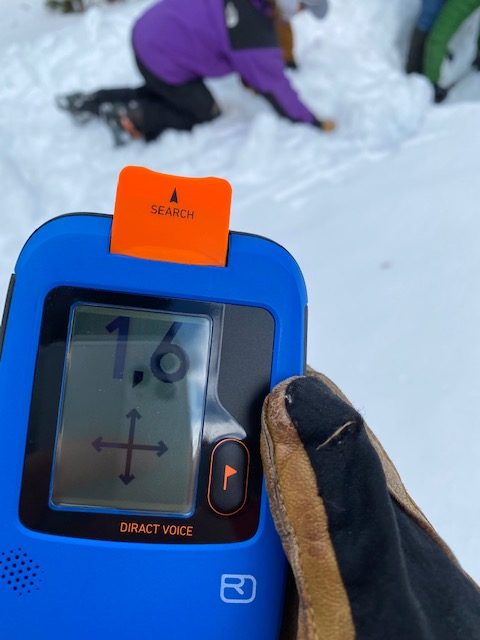
The Direct Voice’s screen indicating the user is in fine search mode.
Overall Performance: Drumroll please……..will I be replacing my Pieps Pro BT with the new Ortovox Diract Voice? The answer is no. Both beacons are top-notch and offer outstanding performance in many categories. I think the Diract Voice beacon is a great choice for the newly initiated backcountry user or for someone who practices with their beacon once every 5-10 years. I am sticking with my Pieps for the sole purpose of a longer range and getting a signal sooner. For me, these features decreased my search time in head-to-head testing and outweighed all other elements of the Diract Voice that I so appreciate.
You can check out Grove’s Diract Voice first look here.
Kevin Grove is an Engineering Professor at Central Oregon Community College and has been an avid backcountry skier and climber for the past 25 years. He grew up in Montana, attended college at Montana State University in Bozeman, and now calls Bend, Oregon home. He is passionate about snow science and loves to share this passion with COCC students and with the Central Oregon outdoor community. Kevin is AAI Level 3 trained.
Beyond our regular guest bloggers who have their own profiles, some of our one-timers end up being categorized under this generic profile. Once they do a few posts, we build a category. In any case, we sure appreciate ALL the WildSnow guest bloggers!
